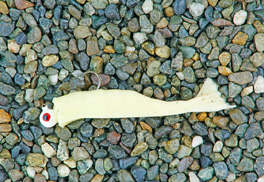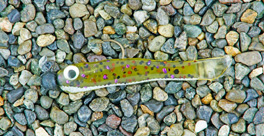Swim Baits


Swim baits are plastic, fish-shaped bodies rigged on a jig-head hook. They mimic bait fish. This is an all-season lure that effectively catches a wide variety of fish species.
It’s easy to rig a swim bait. Just hold it alongside the jig and mark where you want the hook to exit. You can use the hook point to mark the bait. Without squeezing the swim bait, slide the hook point into the front of the swim bait and draw the hook evenly through its body and out the marked exit hole. You don’t want to squeeze the bait while threading the hook because you will likely place the hook off center. It’s best to super glue the bait in place. Simply stop 1/8 of an inch short and place a drop of glue onto the bait holder shank of the jig head. Continue to push the swim bait through so its head is butt jointed against the jig head.
Gluing keeps the bait in place throughout many casts and retrieves. The proper action is maintained. Plastic baits can slide down the jig hook and this alters its action.
The body of the jig assists in causing the swimming or wiggling and wobbling action. The tail also wiggles in a lifelike manner.
Size and color selection should match the bait fish size and color. In dark conditions, the darker swim baits are most visible. In light conditions, the lighter swim baits are best. The most useful sizes range from three to five inches.
As to weight, I match the weight for the water depth to be fished. For shallows, the ¼ ounce is preferred, and for the depths, a ¾ ounce jig head is used. The ½ ounce jig head fishes the mid-depth regions. Smaller baits fish best in the shallows and the larger baits are better for the depths.
Experiment with color, size, and weight until you have found the best producer. Huge swim baits are used for large muskies and outlandish sized bass and stripers.
The action or retrieve is the key to taking fish. Slow retrieves are better than faster ones. I prefer to cast out and then let the swim bait settle to the bottom. I leave it there for about one minute and then start a slow retrieve. I vary this retrieve by raising the rod tip and stopping the retrieve. The swim bait is lifted up, and then it flutters back down on the pause. This is what a sick bait fish does. I then continue a slow retrieve and after a few turns, I jerk the rod tip. This looks like the swim bait has spotted a predator and is trying to flee. This can trigger a reaction strike.
When you are fishing swim baits, commit yourself to making lots of casts and retrieves. Cover a lot of water in search of the fish. Patience is needed to effectively fish swim baits. Also, experiment with steady retrieves, moderately fast, and even fast retrieves. Adjust the presentation to the activity level of the fish.
One disadvantage of swim baits is that they can elicit short strikes. The fish takes hold of the tail and when you strike, the hook cannot penetrate the fish’s mouth. If you are getting short strikes, rig on a trailer hook by tying on the swim bait with a long tag end. Tie the trailer hook onto this tag end and bury it in the tail of the swim bait.
Swim baits work whenever fish feed on bait fish. This means in all seasons. I like to downsize the bait’s size for cold water conditions and for heavily fished areas.
Swim baits are also an excellent follow-up lure for fish that have been fished for with hardware lures. Keep a second outfit in the boat pre-rigged with swim bait. Use it after the hardware has passed through the same water. You may be rewarded with an additional fish or two.
In conclusion, swim baits are effective for a wide variety of conditions and fish. They are easy to fish but require a commitment to patience.


© 2026 The Gale Group, Inc. All rights reserved.
© 2026 Perigee Learning LLC. All rights reserved.
LoveTheOutdoors.com is owned and operated by Advameg, Inc. © 2026 Advameg, Inc.
Camping Adventures • Dutch Oven Cooking • Sports Knots
Fly Tying • Freshwater Fishing • Fly Fishing

